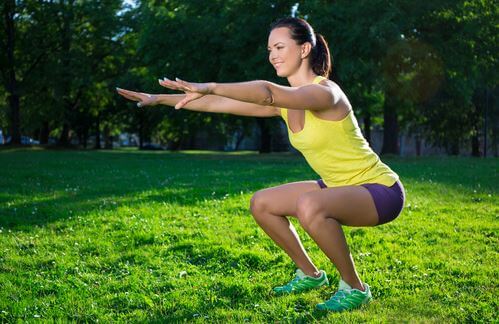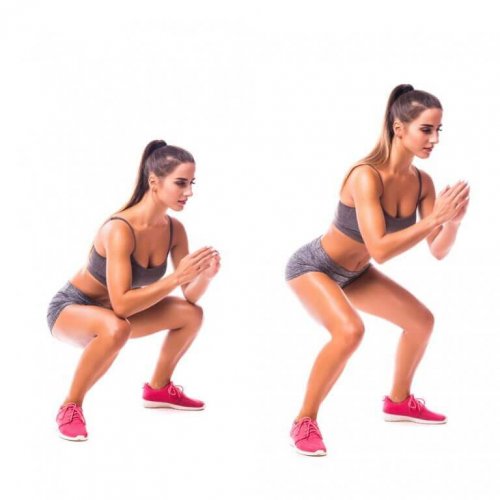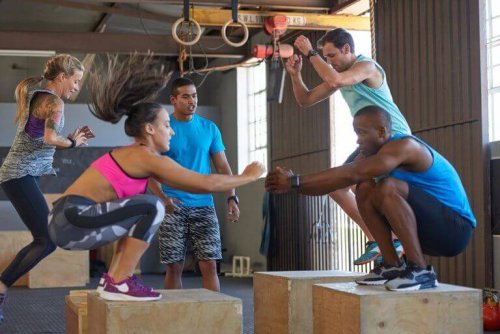Add Jumping Squats to Your Daily Exercise Routine

Jumping squats are a very efficient way to gain strength and resistance in your legs. They’re one of the most “explosive” plyometric exercises. And so, these types of exercises are the ones that athletes use to gain speed and power in their sports performance.
Therefore, these jumping squats have a level of moderate to high demand because you need previous training to perform them. Thus, when performed correctly, they contribute to an efficient warm-up routine and help you to develop muscles of steel!
Benefits of jumping squats
Aside from being an excellent exercise to warm up, jumping squats are ideal to burn calories in a short time. Therefore, this exercise is great if you’re looking to lose a few pounds. Additionally, this exercise generates great power in the quadriceps, glutes, and abductors. It also activates the soleus, hip and knee flexors, biceps femoris, and the hamstrings.
Another advantage of the jumping squats is that they help improve coordination in your body. Since it consists of three or more poses, keeping a steady rhythm means a high level of concentration. It’s also a great exercise to oxygenate the body.
How to perform the jumping squats?
Start out standing straight with the legs shoulder-width apart. Then, just as with a regular squat, bend down with the chest open and the back straight. Additionally, make sure that your knees don’t go over the toe line.

Once you’re at the bottom of the movement, with your hips below your knees, generate enough momentum to jump up and lift your feet off the ground. The height of this jump can vary, and the higher you jump, the faster you’ll gain strength in the leg muscles.
When landing, make sure that your toes land first and your heels last, in order to lessen the impact on the knees. Thus, if you have previous injuries in the knees, we don’t recommend that you perform this exercise.
You can start out with two series of two repetitions, and go on to increase the number of jumping squats. After the first ones, stretch your muscles and then continue with the exercise.
Now, the arms can help to generate the momentum for the jump at first. However, with practice, you can start holding light dumbbells to perform the motion. You can place your arms forward or on your side, whichever is most comfortable for you.
The variety of the jumping squats
1. Frog jump
The main difference with this and the regular jumping squat is that here, your hips are slightly lower. We recommend this option to work more on hip and knee flexibility, as well as improving general posture. You can optimize the variety of this exercise by holding your arms over your head during the jump.

2. Surfing style
For those of you who want a playful twist on the jumping squats, here’s the surfing style. Additionally, it requires more strength and dexterity as well. The objective here is to spin 180 degrees when jumping. Of course, remember to land correctly to avoid injuries and unnecessary pains.
3.The box jump
Adding a CrossFit box makes the exercise even more challenging and therefore provides you with more strength. However, you can use any platform or steady surface that is at 30 to 50 cm off the ground. Therefore, the main objective here is to jump up and fall on the platform and jump back down.

4. Knees to chest jumping squats
Its name says everything about this variant of the exercise. And so, basically, you bend your knees to touch your chest when jumping up. Then, you fall back in the squat position and repeat the exercise one more time.

There are more variants than the ones we’ve mentioned in this article. Additionally, we have the “squat jacks”, half burpee, ninja squats, and the Russian plyometric squat.
And so, as you can see the jumping squats are ideal to achieve strong and powerful legs. You can also use them to train for high-performance sports or if you just want to become fitter.
Jumping squats are a very efficient way to gain strength and resistance in your legs. They’re one of the most “explosive” plyometric exercises. And so, these types of exercises are the ones that athletes use to gain speed and power in their sports performance.
Therefore, these jumping squats have a level of moderate to high demand because you need previous training to perform them. Thus, when performed correctly, they contribute to an efficient warm-up routine and help you to develop muscles of steel!
Benefits of jumping squats
Aside from being an excellent exercise to warm up, jumping squats are ideal to burn calories in a short time. Therefore, this exercise is great if you’re looking to lose a few pounds. Additionally, this exercise generates great power in the quadriceps, glutes, and abductors. It also activates the soleus, hip and knee flexors, biceps femoris, and the hamstrings.
Another advantage of the jumping squats is that they help improve coordination in your body. Since it consists of three or more poses, keeping a steady rhythm means a high level of concentration. It’s also a great exercise to oxygenate the body.
How to perform the jumping squats?
Start out standing straight with the legs shoulder-width apart. Then, just as with a regular squat, bend down with the chest open and the back straight. Additionally, make sure that your knees don’t go over the toe line.

Once you’re at the bottom of the movement, with your hips below your knees, generate enough momentum to jump up and lift your feet off the ground. The height of this jump can vary, and the higher you jump, the faster you’ll gain strength in the leg muscles.
When landing, make sure that your toes land first and your heels last, in order to lessen the impact on the knees. Thus, if you have previous injuries in the knees, we don’t recommend that you perform this exercise.
You can start out with two series of two repetitions, and go on to increase the number of jumping squats. After the first ones, stretch your muscles and then continue with the exercise.
Now, the arms can help to generate the momentum for the jump at first. However, with practice, you can start holding light dumbbells to perform the motion. You can place your arms forward or on your side, whichever is most comfortable for you.
The variety of the jumping squats
1. Frog jump
The main difference with this and the regular jumping squat is that here, your hips are slightly lower. We recommend this option to work more on hip and knee flexibility, as well as improving general posture. You can optimize the variety of this exercise by holding your arms over your head during the jump.

2. Surfing style
For those of you who want a playful twist on the jumping squats, here’s the surfing style. Additionally, it requires more strength and dexterity as well. The objective here is to spin 180 degrees when jumping. Of course, remember to land correctly to avoid injuries and unnecessary pains.
3.The box jump
Adding a CrossFit box makes the exercise even more challenging and therefore provides you with more strength. However, you can use any platform or steady surface that is at 30 to 50 cm off the ground. Therefore, the main objective here is to jump up and fall on the platform and jump back down.

4. Knees to chest jumping squats
Its name says everything about this variant of the exercise. And so, basically, you bend your knees to touch your chest when jumping up. Then, you fall back in the squat position and repeat the exercise one more time.

There are more variants than the ones we’ve mentioned in this article. Additionally, we have the “squat jacks”, half burpee, ninja squats, and the Russian plyometric squat.
And so, as you can see the jumping squats are ideal to achieve strong and powerful legs. You can also use them to train for high-performance sports or if you just want to become fitter.
All cited sources were thoroughly reviewed by our team to ensure their quality, reliability, currency, and validity. The bibliography of this article was considered reliable and of academic or scientific accuracy.
- Desafío del mes para estar saludable: Sentadillas con Salto. Get Healthy CT. Recuperado de: http://www.gethealthyct.org/dev/wp-content/uploads/2016/11/Squat-Jumps-Monthly-Challenge-Spanish2.pdf
- Sleivert, G., & Taingahue, M. (2004). The relationship between maximal jump-squat power and sprint acceleration in athletes. European Journal of Applied Physiology, 91(1), 46–52. https://doi.org/10.1007/s00421-003-0941-0
This text is provided for informational purposes only and does not replace consultation with a professional. If in doubt, consult your specialist.








